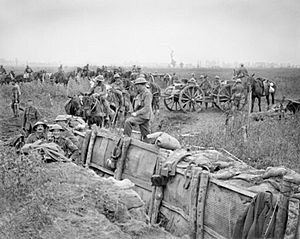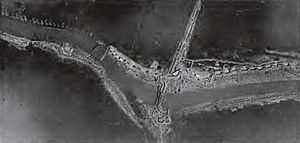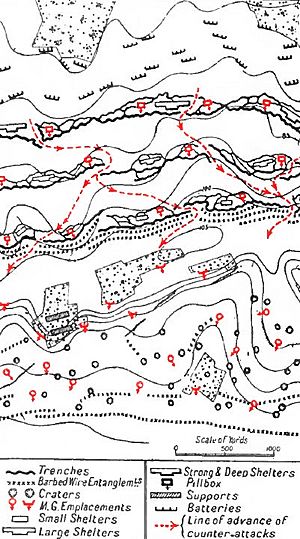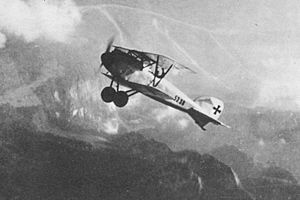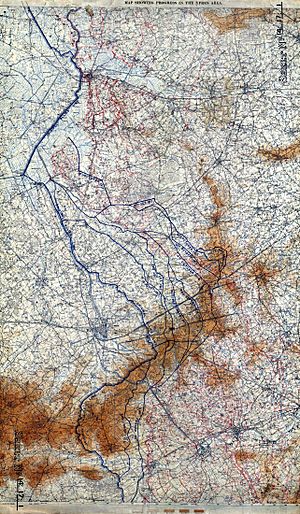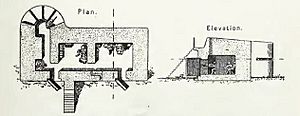Battle of Pilckem Ridge facts for kids
Quick facts for kids Battle of Pilckem Ridge |
|||||||
|---|---|---|---|---|---|---|---|
| Part of the Battle of Passchendaele on the Western Front of the First World War | |||||||
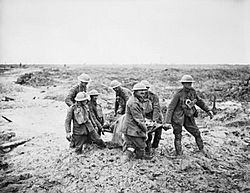 British stretcher bearers carrying a wounded man over deep mud near Boesinghe |
|||||||
|
|||||||
| Belligerents | |||||||
|
|||||||
| Commanders and leaders | |||||||
| Douglas Haig Hubert Gough Herbert Plumer François Anthoine |
Erich Ludendorff Crown Prince Rupprecht Sixt von Armin |
||||||
| Strength | |||||||
| 13 divisions | 7 divisions | ||||||
| Casualties and losses | |||||||
|
British (31 July – 3 August): 31,820 French (26–30 July): 500 (31 July): 1,300 (180 killed) |
21–31 July: c. 30,000 31 July: 5,626 (POW) |
||||||
The Battle of Pilckem Ridge was a major battle during the First World War. It took place from July 31 to August 2, 1917. This battle was the very first attack of the larger Third Battle of Ypres.
British and French armies worked together in this fight. They attacked the German army on the Western Front in Belgium. The goal was to capture Pilckem Ridge and the areas around it. The French army had great success in their part of the attack. However, heavy rain started on July 31, making the battlefield very muddy.
The British and French armies gained a lot of ground. But on the right side, at the Gheluvelt Plateau, they didn't capture as much. Many German soldiers were killed or captured. About 5,626 German prisoners were taken. German counter-attack units, called Eingreif divisions, managed to take back some land.
For the next few days, both sides tried to improve their positions. The heavy rain made fighting very difficult. The bad weather caused many problems for the British and French. They were trying to advance into an area already damaged by artillery fire and partly flooded.
Because of the rain, the next big attacks were delayed. The main goals on the Gheluvelt Plateau were not reached until September 20. This was during the Battle of the Menin Road Ridge. The Third Battle of Ypres became a very debated topic. People argued about the weather and the battle's mixed results.
Contents
Why the Battle Happened
Plans for Flanders
Since 1914, the British government wanted to fight in Flanders, Belgium. In 1916, General Douglas Haig ordered plans for an attack in the Ypres area. But other big battles, like Verdun and the Somme, kept the British army busy.
In early 1917, the French army tried a large attack called the Nivelle Offensive. It didn't go as planned. French soldiers became very tired and morale dropped. So, the British army had to take the lead in attacking on the Western Front.
In June 1917, the British War Cabinet agreed to a campaign in Flanders. The French army, led by General Philippe Petain, decided to defend their lines. They also planned smaller, strong attacks to help their soldiers feel better. The French First Army was to join the British Flanders offensive.
British Attack Ideas
In late 1916, General Herbert Plumer was asked to plan an attack from the Ypres area. Haig wanted a bigger plan than just capturing Messines Ridge and Pilckem Ridge. Plumer updated his plan to capture these ridges and advance further. This plan needed many soldiers and guns, more than the British army had.
By May 1917, Haig decided the attack on Messines Ridge would be on June 7. The Flanders offensive would start a few weeks later. The main goal was to wear down the German army. They also wanted to secure the Belgian coast and move towards the Dutch border. This would cut off German supplies.
General Hubert Gough was put in charge of the Flanders offensive. He was given the main plan for the attack.
Getting Ready for Battle
Allied Preparations
General Gough met with his commanders in June. They added more objectives to the first day's attack. Five divisions from the British Second Army, nine from the British Fifth Army, and two from the French First Army were to attack.
A huge artillery bombardment was planned from July 16 to 25. The British soldiers practiced on a copy of the German trench system. This was built using photos from planes and information from raids. Some soldiers even trained specially to attack German strongholds called pillboxes.
The plan was ambitious. It aimed for a deep advance on the first day. This was much further than earlier plans. Haig approved Gough's plan, hoping to take advantage if the German defenses broke.
Air Battles Before the Main Attack
| Date | Rain mm |
°F |
|---|---|---|
| 26 | — | 75 |
| 27 | — | 75 |
| 28 | — | 78 |
| 29 | 11.5 | 69 |
| 30 | 0.5 | 65 |
Allied air activity increased over Ypres. German air forces, called the Luftstreitkräfte, fought back strongly. On July 12, there was a record amount of air fighting. Thirty German fighters fought British and French planes for an hour. The British lost nine planes, and the Germans lost fourteen.
The Germans kept fighting hard in the air until the end of July. Then, their losses forced them to use more defensive tactics. The ground attack was delayed several times because of bad weather. The French needed more time to set up their artillery. Haig finally agreed to delay until July 31.
Allied Attack Plan
The attack would start with the British Second Army on the right. They would advance towards the Warneton line. The British Fifth Army would attack through German defenses. Their goals were about 1,000 to 3,500 yards away. If the Germans collapsed, reserve troops would push even further.
The Fifth Army had many heavy and field guns. The French First Army and parts of the Second Army also provided artillery support. Gough also planned to use 120 Mark IV tanks to help the attack.
The artillery bombardment was meant to destroy German strong points and cut barbed wire. British soldiers would advance behind a "creeping barrage." This was a moving wall of artillery fire. British intelligence thought the main German resistance would be at the Albrechtstellung (second position). They expected immediate German counter-attacks on the Gheluvelt Plateau.
French Northern Flank
The French First Army had many guns and mortars. They took over from Belgian divisions from July 5 to 10. The land in this area was very wet and flooded. The Germans had built defenses above the water, as digging was impossible.
The French I Corps was to form the northern part of the attack. They would cross a strip of land between the Yser Canal and the flooded areas. Their first goal was to take two German lines east of the canal. The French advance would follow a creeping barrage, just like the British.
German Defenses
The German 4th Army had a strong defensive plan. Their defenses had three main zones: a forward zone, a main battle zone, and a rearward battle zone. The front line had three breastworks (low walls) about 200 yards apart.
About 2,000 yards behind the front was the Albrechtstellung (second position). This was the front of the main battle zone. Further back was the Wilhelmstellung (third position). This zone held most of the German field artillery. Behind these were areas for the Eingreif (counter-attack) divisions.
The Germans planned a strong defense of their front lines. They would use counter-attacks to push back attackers. They had also added many new machine guns to their regiments. This gave their soldiers more firepower. The German air force had about 600 planes in the area.
The Battle Begins
Second Army Attacks
The British bombardment started at 3:50 a.m. It was still dark due to mist and clouds. This time was chosen so the British could see a little, but the Germans would be looking into darkness. The ground was muddy from recent rain.
The attack stretched from Deûlémont north to the Fifth Army's area. The New Zealand Division captured La Basseville after street fighting. The 3rd Australian Division took outposts near Gapaard.
The British IX Corps advanced about 500 yards. They moved towards their first objective. German artillery fire increased around 5:30 a.m. German troops were seen moving forward for a counter-attack. British engineers began to strengthen their captured positions.
A German counter-attack started at 7:40 a.m. Some British groups were pushed back. Reinforcements were called in. More German attacks were repelled later in the day. The British 19th (Western) Division was ordered to hold their ground.
The British X Corps artillery helped the Fifth Army. They fired on German artillery behind Zandvoorde. The 41st Division attacked near the Ypres–Comines Canal. Some German pillboxes were very strong and caused many casualties. The 41st Division advanced about 600–650 yards.
Fifth Army Attacks
| Date | Rain mm |
°F | |
|---|---|---|---|
| 31 | 21.7 | 69 | dull |
| 1 | 5.3 | 59 | — |
| 2 | 5.3 | 59 | — |
| 3 | 9.9 | 59 | — |
| 4 | 4.9 | 66 | dull |
| 5 | 0.0 | 73 | fine |
| 6 | 0.1 | 71 | dull |
| 7 | 0.0 | 69 | dull |
| 8 | 10.2 | 71 | dull |
| 9 | 0.2 | 68 | fine |
| 10 | 1.5 | 69 | fine |
The main British effort was on the Gheluvelt Plateau. This was the hardest area to attack. The 24th Division reached its objective. But the 73rd Brigade was stopped by German pillboxes.
The 30th Division struggled through damaged woods. They were stopped by German machine-gun fire. German artillery fire also made it hard to advance. Some units got lost in the dark and mud. The 30th and 24th Divisions did not advance far. This was due to the muddy ground, losing direction, and many German machine guns still working.
The 8th Division advanced more easily. But their left side became open to German machine-gun fire. This was because the 30th Division had not advanced as far. The 8th Division held its ground and fought off German counter-attacks.
The XIX Corps attacked with the 15th (Scottish) Division and the 55th (West Lancashire) Division. The advance started well, but fortified farms caused delays. Some tanks helped by attacking strong points. After a pause, reserve brigades advanced further. The 55th (West Lancashire) Division fought through many German strong points. They advanced about 4,000 yards.
The 39th Division advanced and captured St Julien. They took 222 prisoners. Two tanks helped silence a German artillery battery. The 117th Brigade captured three pillboxes. They killed the machine-gunners and took prisoners. Tanks helped clear barbed wire and keep German soldiers hidden. By 8:00 a.m., both brigades reached their final objective. They started digging in on the east side of the Steenbeek river.
The 51st (Highland) Division found many Germans in shell holes and took them prisoner. Tanks helped clear German positions. As the Scottish soldiers reached the Steenbeek, machine-gun fire stopped them. Both divisions dug in along the river for 3,000 yards.
In the XIV Corps area, the Guards Division crossed the Yser Canal on July 27. The German front line was empty. The Guards moved forward about 500–700 yards. The 38th (Welsh) Division on the right faced German fire. On July 31, the British and French advanced 3,000–3,500 yards to the Steenbeek River. The bombardment had destroyed German front lines. Cavalry tried to advance but were stopped by German fire.
French First Army Attacks
By dawn on July 30, the French 1st and 51st divisions were ready. They were protected by a gas bombardment. Bridges were built over the canal. The attack started at 3:50 a.m. on July 31. The French used 39 bridges to cross the Yser Canal.
The German first line was taken easily. French machine-gun companies fired over the advancing troops. No German machine guns fired on the French as they moved forward. German artillery fire was light at first.
The 1st Division reached its first objective by 5:40 a.m. The 51st Division also reached its goals with few casualties. Supporting battalions advanced towards the second objective. They arrived before 7:00 a.m. German artillery fire increased, causing more casualties.
Reserve battalions pushed towards the third objective. They faced strong resistance from pillboxes. Machine-gunners fired from close range. This slowed the French advance. German artillery began to bombard French positions. By 9:00 a.m., the French advance had slowed.
French planes reported that the 1st Division had reached its goals. The 51st Division was also at its objectives. By 11:00 a.m., the 51st Division held a line from Coquelicot Trench to the south of Bixschoote. They took several prisoners.
French artillery crossed the canal. They destroyed German troops gathering for a counter-attack. By 1:30 p.m., the 1st Division had advanced beyond its final objective. The sky cleared around 2:00 p.m. French aircrews warned of a German counter-attack. This attack was pushed back at 5:00 p.m.
The French I Corps reached its goals. They pushed northward and found no Germans near Poesele. The French advanced further to create a strong defensive zone. Many new French positions were in shell craters filled with water. Contact with the rear was difficult. A German counter-attack got stuck in deep mud. The next four days were very rainy, making supply difficult.
Air Operations
On July 26, British fighters fought German planes near Polygon Wood. The next evening, British planes lured German fighters into an ambush. After an hour, nine German planes were shot down. The British lost two.
On July 27, a British air report helped XIV Corps take 3,000 yards of the German front line. On July 31, the Allied air plan was cancelled due to thick clouds. But some pilots flew anyway. They observed the ground battle very closely. Thirty British aircraft were damaged by bullets and shells.
German Counter-attacks
At noon, the German army stopped the British II Corps. News of the British reaching the green line further north was slow to arrive. This was because of mist, mud, and cut signal cables.
Around 3:00 p.m., General Gough ordered all XIX Corps troops to advance. But delays continued. A German force was not seen by British aircraft. Rain began soon after, blocking British artillery observers.
At 2:00 p.m., a German creeping barrage began. German troops attacked the sides of the most advanced British positions. The 39th Division was pushed back. This left the 55th (West Lancashire) Division exposed. It was then attacked by six waves of German infantry.
Attempts to hold the ground failed due to communication problems. The speed of the German attack and worsening visibility also played a role. The British brigades beyond the black line were forced back. By 6:00 p.m., the Germans reached the Steenbeek. The heavy rain added to the mud and flooding. The British stopped the German advance with artillery and machine-gun fire.
The success of the British advance in the center surprised the German commanders. The German defense was meant to slow attackers, not allow a 4,000-yard advance. German reserve divisions began a counter-attack. The advanced British brigades were tired and out of touch with their artillery. The Germans pushed the British back to the black line. They recaptured St Julien. The three British brigades suffered 70 percent casualties.
German counter-attacks on the sides had little success. In the XIV Corps area, German attacks failed against British troops. The Guards Division held its ground. The French pushed back German counter-attacks and captured Bixschoote. German counter-attacks on the Gheluvelt Plateau were also pushed back. In the Second Army area, a strong German counter-attack was stopped by the New Zealand Division.
After the Battle
Casualties and Losses
In 1931, Hubert Gough said that 5,626 German prisoners were taken on July 31. The British Official History reported British Fifth Army casualties from July 31 to August 3 as 27,001. Of these, 3,697 were killed. Second Army casualties were 4,819, with 769 killed.
The French First Army had about 1,300 casualties on July 31, with 180 killed. The German 4th Army suffered about 30,000 casualties from July 21 to 31. One German officer said that units that survived physically no longer had the mental ability to continue.
What Happened Next
Southern Flank
On the Second Army front, German artillery kept firing on the new British front line. This, along with the rain, made it very hard for the British to hold their captured ground. On August 1, a German counter-attack was stopped by British artillery and machine-gun fire.
Operation Summer Night
Operation Summer Night was a German counter-attack near Hollebeke. It began at 5:20 a.m. on August 5. German troops captured a small hill. This surprised the British, who fell back. The new German positions were on higher, drier ground. This made it harder for British artillery to hit them.
Further south, German soldiers attacked Hollebeke through thick fog. They captured the village and took at least 300 prisoners. Most British soldiers were in captured pillboxes. These had to be attacked one by one. The Germans later left Hollebeke and went back to their starting line. This was because of strong British counter-attacks and artillery fire.
Central Area
On August 1, a German counter-attack pushed back the British 8th Division a short distance. But the 15th (Scottish) Division stopped the attack with artillery fire. Two British battalions counter-attacked and got their original line back.
On August 2, the Germans attacked again. They were pushed back by artillery fire. German troops seen in Kitchener's Wood were bombarded. St Julien was re-occupied by the British. More advanced posts were set up by the 51st (Highland) Division on August 3.
A German attack on August 5 recaptured part of Jehovah Trench. But it was lost again the next day. On August 7, the Germans blew up a bridge over the Steenbeek. On August 9, the 11th (Northern) Division took two pillboxes without a fight. They pushed posts further beyond the Steenbeek.
The 29th Division took Passerelle Farm. They set up posts east of the Steenbeek. They also built twelve bridges across the river. The 20th (Light) Division moved forward on August 13. On August 14, they took Mill Mound and four concrete shelters. The British had to dig in short of a blockhouse. They pushed back a German counter-attack the next day.
Capture of Westhoek
The Gheluvelt Plateau was a sea of mud and flooded shell craters. Soldiers quickly got tired from the rain, mud, and constant artillery. The British Fifth Army bombarded German defenses. But the German guns focused on the Plateau.
Low clouds and rain stopped British observation planes. Many shells were wasted. By August 10, both sides were exhausted. Some British troops reached their goals quickly. But German artillery cut off those around Inverness Copse. German counter-attacks recaptured the Copse. The 25th Division reached its goals by 5:30 a.m. and rushed the Germans in Westhoek. Both sides had many casualties.
Northern Flank
The French 1st and 51st divisions had few casualties. They continued their attacks up to the Steenbeek. On August 4, the French moved forward and took two farms. During August 8 and 9, the French took more ground.
On August 6, the French I Corps was ordered to push Germans out of their positions. They were to set up good defenses. From August 4 to 6, the 1st and 51st divisions were replaced by fresh troops. On August 8, Loobeek Farm was taken without a fight.
On August 9, the French advanced closer to Langewaade. It seemed weakly held. The 2nd Division took two farms. At dawn on August 10, French Marines attacked. They gained more starting points for an attack on Drie Grachten.
After advancing, the French occupied the west side of the flooded areas. They also set up bridgeheads across the Steenbeek. Five guns were captured. The French were close to Merckem. This outflanked German defenses at Drie Grachten. It also made Langemarck vulnerable to attack. By August 10, the French I Corps held a strong line.
Images for kids



